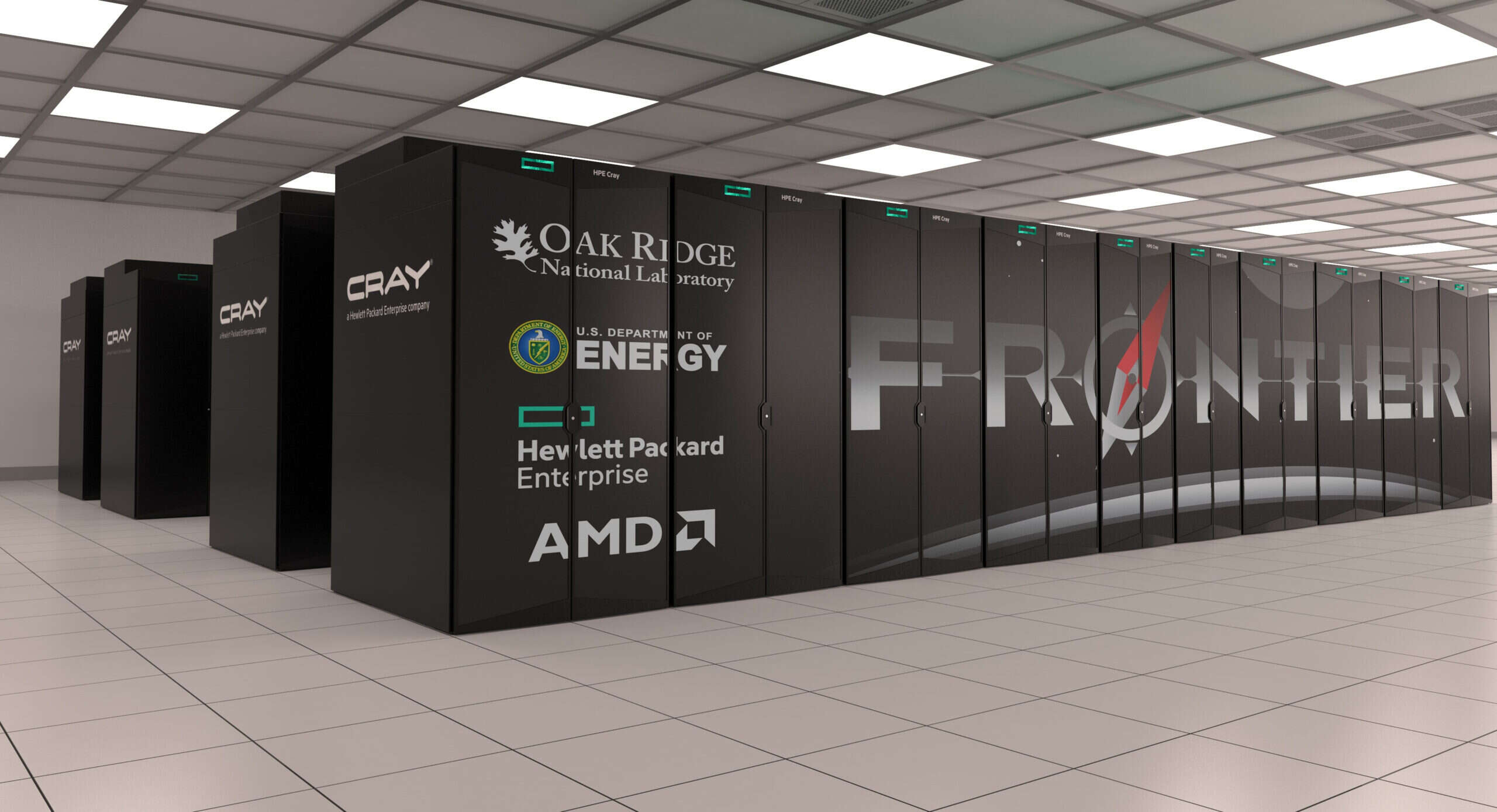
A US supercomputer has broken the exascale barrier, performing at 1.1 exaflops according to the latest ranking of the world’s top-performing high-performance computers published by Top500. This means the machine, Frontier, can perform a quintillion calculations a second.
Supercomputers are becoming strategic national assets for countries around the world, with the US currently leading the way when it comes to research and development.

Frontier is based at the US Department of Energy’s Oak Ridge National Laboratory (ORNL) and is built on the Hewlett Packard Enterprise Cray EX235a architecture, using third generation AMD EPYC processors.
The machine beat out the Japanese Fugaku system which had held top place for the past two years with a score of 442 Petaflops. Fugaku had an exaflop peak, but wasn’t able to demonstrate that in benchmark tests so can’t be considered a true exoscale machine, Top500 said.
First supercomputer to break exascale
Released today, the Spring edition of the Top500 shows the average speed performance of the entire group of supercomputers benchmarked is increasing less quickly than in the past, and significantly more slowly than the top performer, which has doubled its peak in the past two years.
“Today’s debut of the Frontier exascale supercomputer delivers a breakthrough of speed and performance, and will give us the opportunity to answer questions we never knew to ask,” said Justin Hotard, executive vice president and general manager for HPC and AI at HPE.
The top ten is dominated by US-based machines, with Frontier and Fugaku way out in front, but features a second European supercomputer, Lumi, for the first time. Based in in Finland it takes third spot with 1.11 million cores and a benchmark of 152 petaflops.
Hotard says the machine will be used to unleash a “new level of capability to deliver open science, AI and other breakthroughs, that will benefit humanity”. It is the first in a new line of exoscale supercomputers being developed by HPE.
The system contains a total of 9,408 CPUs and 37,632 GPUs. “We are excited that AMD EPYC processors and AMD Instinct accelerators power the world’s fastest, most energy efficient, and first supercomputer to break the exascale barrier,” said Forrest Norrod, senior vice president and general manager, Data Center Solutions Group, AMD. “Innovation and delivering more performance and efficiency for supercomputers is critical to addressing the world's most complex challenges."
With a peak performance of two exoflops, ORNL Director Thomas Zacharia says that power will be put to good use, both in terms of scientific discovery but also for industry and material science.
"Frontier is ushering in a new era of exascale computing to solve the world’s biggest scientific challenges,” he said in a statement. “This milestone offers just a preview of Frontier’s unmatched capability as a tool for scientific discovery.”
As well as modelling and simulating complex scientific research – across a range of sciences including chemistry, physics and biology – Frontier will also be used in artificial intelligence research, as its AI capabilities allow for models to be eight times larger and created 4.5 times faster than the next fastest supercomputer, according to HPE.
Able to solve complex problems
“When researchers gain access to the fully operational Frontier system later this year, it will mark the culmination of work that began over three years ago involving hundreds of talented people across the Department of Energy and our industry partners at HPE and AMD,” says Jeff Nichols, associate lab director, computing and computational sciences, Oak Ridge National Laboratory. "Scientists and engineers from around the world will put these extraordinary computing speeds to work to solve some of the most challenging questions of our era, and many will begin their exploration on Day One.”
The Frontier supercomputer also racked up impressive environmental credentials, coming second in the 2022 Green500 list, where supercomputers are ranked by their flops per watt. This machine delivered 52.23 gigaflops per watt, within the sustainability target for exascale machines target set by US research agency DARPA.
The strategic importance of supercomputers
Japan is considering how to tackle a post-Fugaku future. As the US pushes further into exascale territory, funding for similar new developments in Japan is limited, according to Nikkei Asia.
Fugaku has proved a useful tool for Japanese businesses, with machine manufacturing company DMG Mori Seiki using it to model the suitability of new materials for use in its products. Using Fugaku has cut this process to ten minutes, where it would take a standard machine eight hours or longer.
Supercomputers are increasingly seen as strategic national assets as countries around the world look to shore up their digital sovereignty and support their domestic tech industries. The EU has committed funding to try and build a high performance computing ecosystem on the continent, while the UK's plan is to have an exascale machine up and running by 2025. "That would make us competitive with Europe," Professor Mark Parsons, director of the Edinburgh Parallel Computing Centre (EPCC) at Edinburgh, told Tech Monitor last year. "We'd still be a wee bit behind the US, China and Japan, but it would put us at the level we should be as a science superpower."
Japan is also looking for sovereignty when it comes to supercomputers. University of Tokyo professor Kazuto Sazuki told Asia Nikkei: "In economic security, Japan is not aiming to be the top [in terms of calculation speeds]. It is more important to build a system that can utilize supercomputers without relying on other countries."
For the US, the next exascale system will come in the form of Argonne National Laboratory's Aurora next year, followed by the Lawrence Livermore National Laboratory's El Capitan system in 2023.






